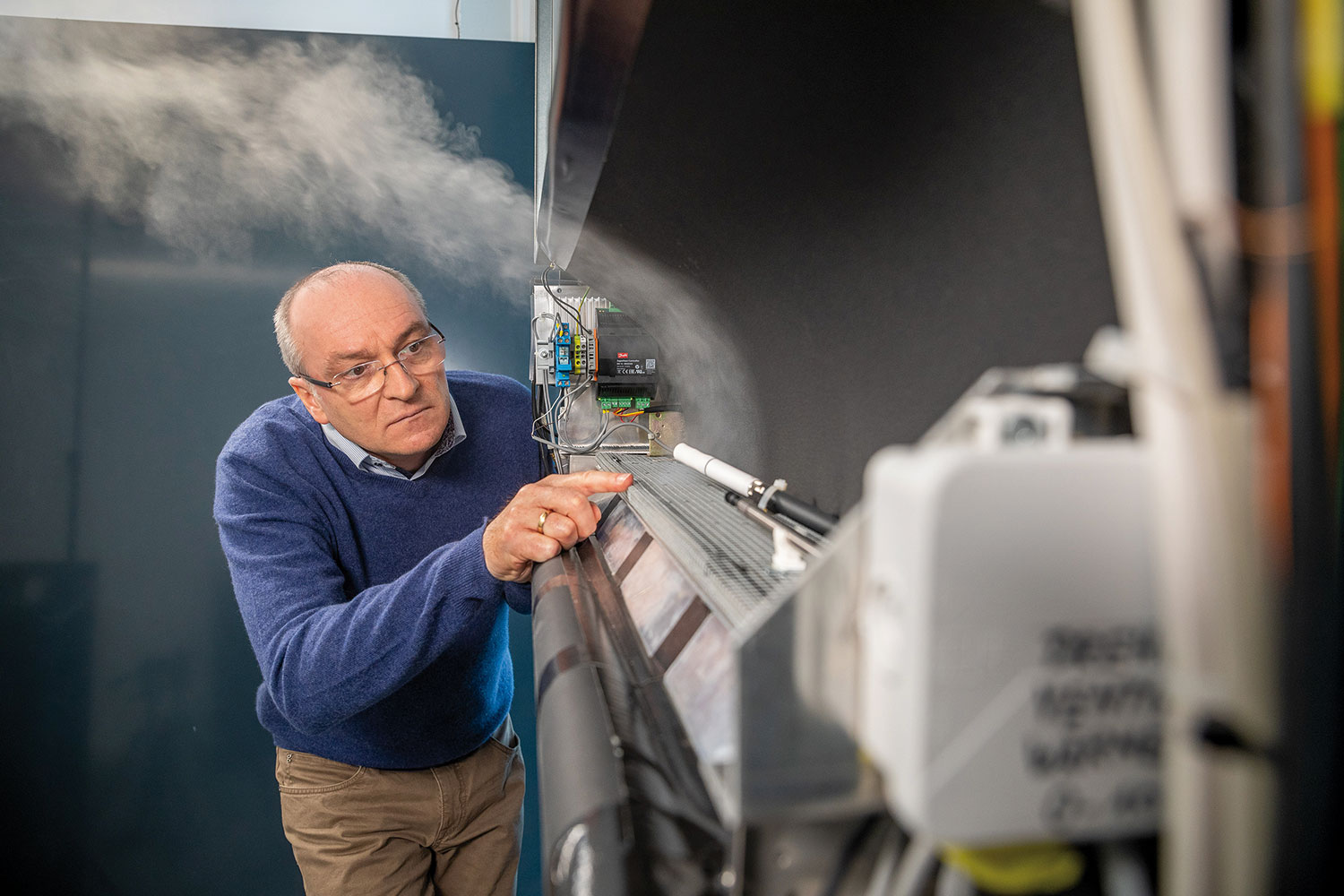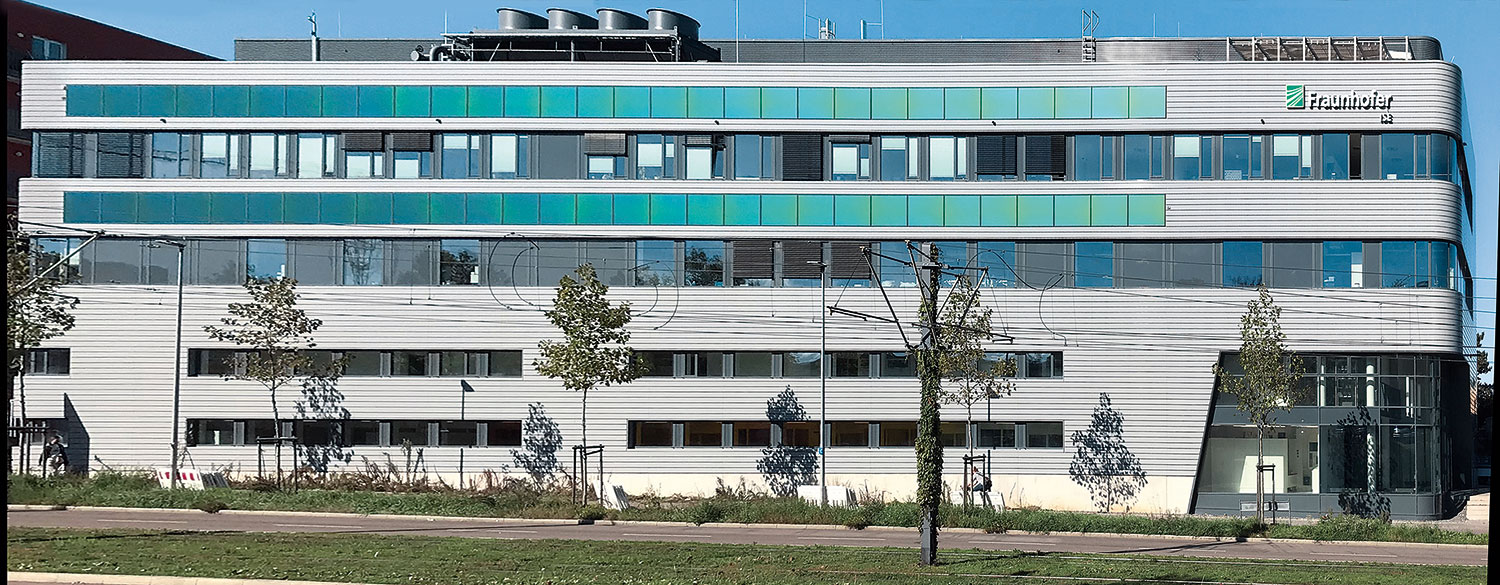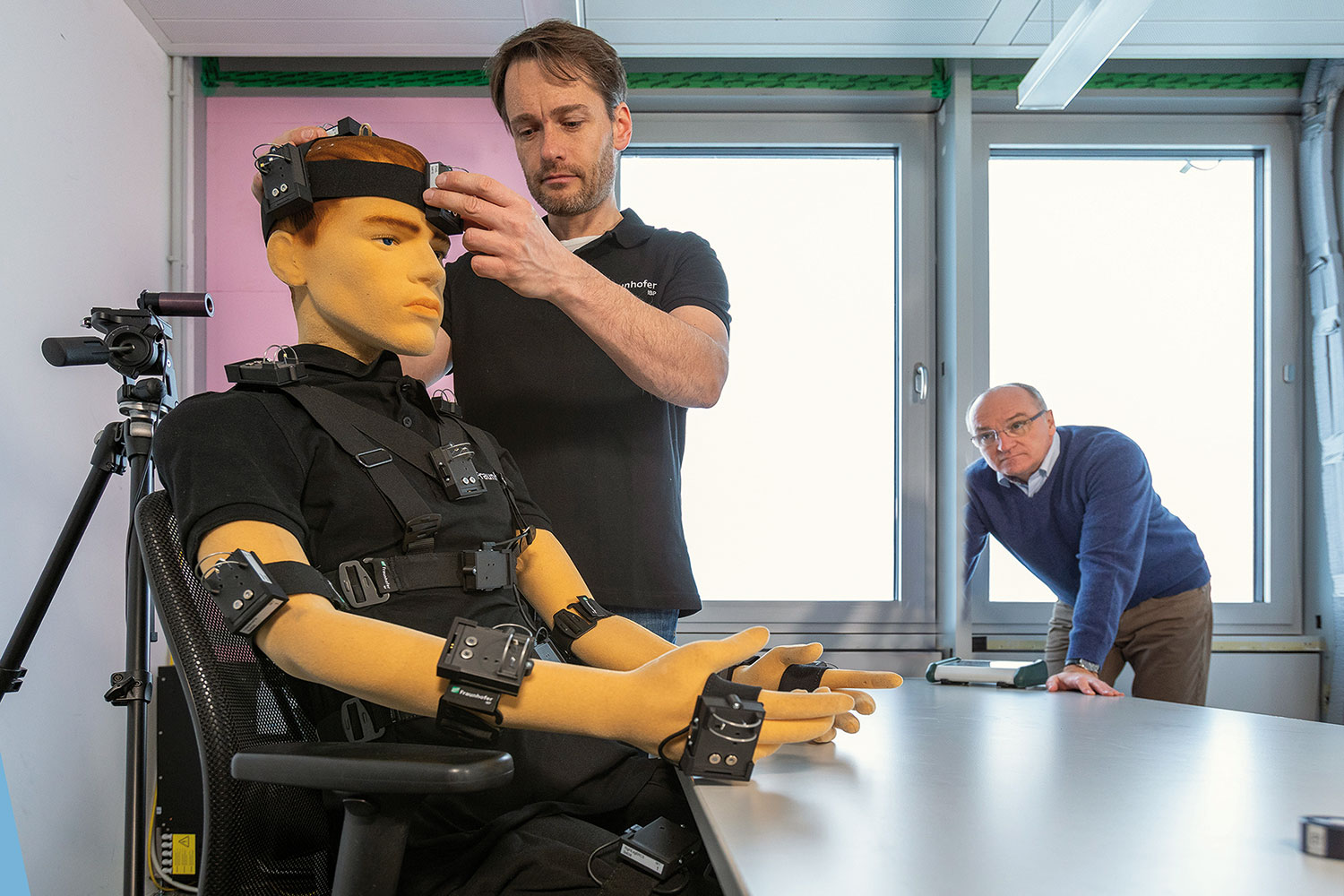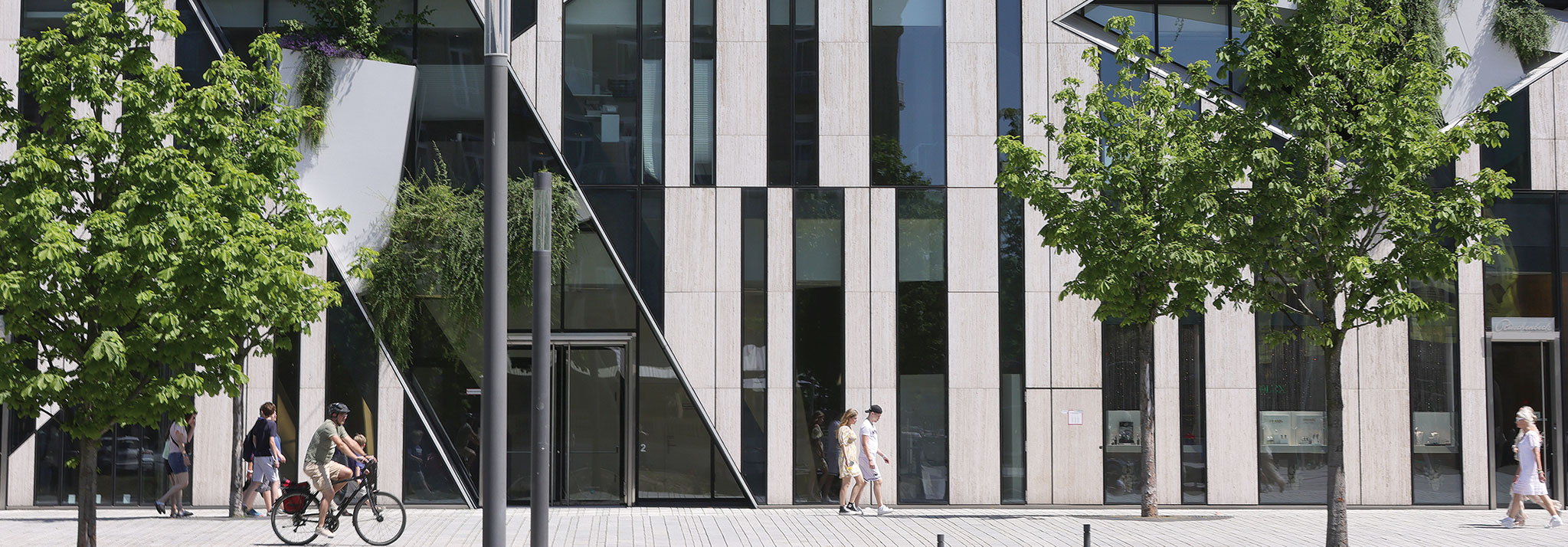Web special Fraunhofer magazine 2.2023
More than a facade
Energy Efficiency and Indoor Climate
A three-storey house in Holzkirchen, Bavaria sits within earshot of the A8 autobahn; at first glance, it could be mistaken for an office building. But take a closer look and you’ll notice that the facade has some unusual features: floor-to-ceiling windows, external roller blinds, a sunshade attached from the inside. On the third floor, there is a black photovoltaic module attached between two windows on the external facade. Why the inconsistency? There is method to the apparent madness of this exterior design. This mini high-rise is no ordinary building – it’s an experimental facility for energy and indoor climate studies (Versuchseinrichtung für energetische und raumklimatische Untersuchungen, VERU). It is run by the Fraunhofer Institute for Build[1]ing Physics IBP in the Upper Bavarian municipality of Valley, and its ability to transform its facade is one of the key features of its design. Between an underlying structure of reinforced concrete, there are individual segments that can be quickly and easily swapped out for new facade solutions. This allows the function and efficiency of these solutions to be tested for the purposes of research or on behalf of industry.
The VERU - Modular Test Facility for Energy and Indoor Environments of the Fraunhofer Institute for Building Physics IBP in Holzkirchen, Germany.
Facades that make a difference, both inside and out
Herbert Sinnesbichler, the group manager for Evaluation and Demonstration at Fraunhofer IBP, is master of the test house. Mr. Sinnesbichler is a technical physicist who joined Fraunhofer IBP as a graduate student; he has been conducting tests on solar shading and cladding systems at VERU for nearly 20 years alongside an interdisciplinary team. To him, a facade is more than just a creative cover for a building. “A facade is the point of contact between a building and the outside world; as such, it has a significant effect on the property’s energy demand and can create a comfortable climate within the rooms.” In Mr. Sinnesblicher’s expert opinion, anyone who reduces a building facade to its purely aesthetic function is underestimating its potential in terms of physical construction possibilities and energy use. Future facades will have a laundry list of tasks: keeping out the wind and weather, letting in light, maintaining the best possible indoor temperature throughout all four seasons and, ideally, generating additional energy (see: building-integrated photovol - taics, BIPV) − and looking good while doing it. Fraunhofer UMSICHT has added yet another item to this list. For more than eight years, UMSICHT researchers have been working on vertical greening systems that allow building facades to become active parts of urban environments. “Together with partner companies, we have developed special construction elements for building green walls that are not attached to the ground,” explains Holger Wack, deputy head of the Product Development department at Fraunhofer UMSICHT. Vertical greening processes involving grasses, flowers, herbs and even crops can improve air quality, decrease CO2 levels, reduce noise and bind fine particulates. They also counteract some effects of climate change, including heavy rain, heat, drought and biodiversity loss.

Inspired by butterflies
For several months, the Center for Highly Efficient Solar Cells at the Fraunhofer Institute for Solar Energy Systems ISE has been fitted with BIPV facade modules that can become green – literally. On top of supplying the institute with around eleven megawatt hours of solar power per year, this pilot project will also give the building green accent walls. This is made possible by the MorphoColor® coating developed by Fraunhofer ISE, which adds color to the solar panels while maintaining at least 90 percent of the modules’ efficiency. In developing this design, the researchers looked to nature. Blue morpho butterflies do not simply have blue pigments in their wings to give them their distinctive hue – instead, the impression of luminous color is created by a multitude of waferthin scales layered on top of each other like bricks. These refract incident light in such a way that only the blue light waves are reflected back. Similarly, the coating on the MorphoColor® panels reflects only a certain color of the light spectrum, while the rest of the sunlight can pass through the layer unimpeded and be used for energy. By combining aesthetics with functionality, these panels have the potential to win over customers that remain hesitant about the idea of BIPV modules. It would be relatively easy to integrate these PV modules into the many surfaces on building facades that are already extensively glazed. Fraunhofer ISE estimates the technical potential of BIPV modules in facades in Germany (including both residential and non-residential buildings) to be around 440 gigawatts at peak – just slightly less than the potential of BIPV modules on roofs (560 GWp). The addition of colors could help increase this potential. However, despite providing solar energy, glass facades come with a considerable problem: Along with light, they let in heat, which can be especially problematic in summer.

The PV module currently in place on the southern face of Fraunhofer IBP’s VERU facility could help here. Part of a facade module for air conditioning in buildings, it was developed by Fraunhofer IBP and the Fraunhofer Institute for Energy Economics and Energy System Technology IEE in collaboration with industry partners. The photovoltaic element generates enough renewable energy to ventilate the office space on the other side of the wall; in addition, it has a miniature heat pump that allows for heating and cooling. As such, it represents an all-inclusive solution: All of the heating, cooling and ventilation technology needed for the office space indoors is integrated into the facade module.

But does the renewable energy (RE) modular facade work as intended? Michael Eberl, a scientist at Fraun hofer IBP, has equipped the facade of the VERU test room with a prototype and fitted out the room itself with all kinds of measurement technology that will examine the functionality of the system, record energy flows and measure comfort parameters such as air temperature, humidity and air velocity. Two black metal tubes in the center of the room are used in combination with humidifiers to represent the heat and humidity inputs of the office workers that will one day work on the other side of the wall from a RE modular facade such as this. This functional mock-up is used to test and optimize the module itself and the interactions between the various components in the room. Although he doesn’t want to make any predictions regarding test results, Mr. Eberl is quite satisfied so far.
These experimental setups generally run for at least nine months, in order to include as many seasonal changes as best as possible. Mr. Sinnesbichler says the VERU site in Valley is ideal for this because of its extreme weather conditions: Be it sun, wind, rain, frost or snow, the foothills of the Alps see plenty of every type of weather over the course of a year. Now, in early Spring, snow and fog are still enveloping the VERU in a wintry shroud of white and gray; it is bitterly cold in front of the experimental building and in the stairwell. However, the prototype test room itself is warm and toasty – another good sign.
For large-scale building projects, around 15 to 25 percent of construction costs go toward creating the facade. In view of the sheer scale of the costs, it is a good idea to invest in pre-testing new designs and concepts using functional mock-ups. This can help detect possible weak points at an early stage and avoid expensive efforts to rework the finished structure. “Relying solely on the drawing board and digital simulations means accepting a high level of risk,” says Mr. Sinnesbichler, an engineering graduate. Simulation tools are often used during the studies conducted at VERU. However, the models used for this purpose are usually checked and validated on the basis of real measured values collected beforehand.
A glimpse behind the facade
VERU turns the concept of flexibility into a house: The measuring cells are so variable that it is possible to simulate different structures, including individual offices, open-plan offices and conference rooms, without any problems. Moreover, the second floor hosts two identical test rooms – known as energetic twin rooms – that can allow for comparative measurements. Now and again, people are invited to take part in the tests so that researchers can look beyond the objective measurement data and record subjective impressions of the indoor climate. This usually takes a lot of time and effort, however: “If we want the data to be representative, we must invite a really high number of people to the test,” explains Mr. Sinnesbichler. That is why the team at Fraunhofer IBP prefers to use DressMAN – a life-size climate measuring manikin that is equipped with numerous sensors, from its blue sneaker-clad feet to its synthetic forehead. Mr. Eberl carefully bends the dummy’s limbs until it sits at a desk like a human being. All the measurement data that the DressMAN (or woman, as there is of course also a female version) provides to researchers is fed into an algorithm that can be used to calculate the overall thermal comfort of the room. For companies, the comfort of DressMAN – and as a result, of their office workers – is a high priority. Compared to employees that enjoy a good work climate – literally – employees that spend their working day sweating, freezing or complaining about drafts are less produc[1]tive and more prone to making mistakes. In order to know how it feels to be inside a room that is equipped with a certain facade solution, to understand what it’s like to sit and work there, “you just have to sit there and feel it,” says Mr. Sinnesbichler. If he was able to, DressMAN would probably agree.
- Test facility for energetic and indoor environment investigations (VERU) (pruefstellen.ibp.fraunhofer.de)
- Vertical greening in urban areas (umsicht.fraunhofer.de)
- Center for High Efficiency Solar Cells (ise.fraunhofer.de)
- Building-Integrated Photovoltaics (BIPV) (ise.fraunhofer.de)
- Modular facade with integrated systems technology supplies buildings with renewable energy (fraunhofer.de)
